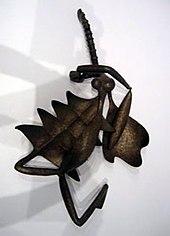Expansion
André Masson. Automatic Drawing. 1924. Ink on paper, 23.5 x 20.6 cm. Museum of Modern Art, New York.
Giacometti's Woman with Her Throat Cut, 1932 (cast 1949), Museum of Modern Art, New York City
Soon more visual artists became involved, including Giorgio de Chirico, Max Ernst, Joan Miró, Francis Picabia, Yves Tanguy, Salvador Dalí, Luis Buñuel, Alberto Giacometti, Valentine Hugo, Méret Oppenheim, Toyen, Kansuke Yamamoto and later after the second war: Enrico Donati. Though Breton admired Pablo Picasso and Marcel Duchamp and courted them to join the movement, they remained peripheral.[17] More writers also joined, including former Dadaist Tristan Tzara, René Char, and Georges Sadoul.
In 1925 an autonomous Surrealist group formed in Brussels. The group included the musician, poet, and artist E. L. T. Mesens, painter and writer René Magritte, Paul Nougé, Marcel Lecomte, and André Souris. In 1927 they were joined by the writer Louis Scutenaire. They corresponded regularly with the Paris group, and in 1927 both Goemans and Magritte moved to Paris and frequented Breton's circle.[6] The artists, with their roots in Dada and Cubism, the abstraction of Wassily Kandinsky, Expressionism, and Post-Impressionism, also reached to older "bloodlines" such as Hieronymus Bosch, and the so-called primitive and naive arts.
André Masson's automatic drawings of 1923 are often used as the point of the acceptance of visual arts and the break from Dada, since they reflect the influence of the idea of the unconscious mind. Another example is Giacometti's 1925 Torso, which marked his movement to simplified forms and inspiration from preclassical sculpture.
However, a striking example of the line used to divide Dada and Surrealism among art experts is the pairing of 1925's Little Machine Constructed by Minimax Dadamax in Person (Von minimax dadamax selbst konstruiertes maschinchen)[18] with The Kiss (Le Baiser)[19] from 1927 by Max Ernst. The first is generally held to have a distance, and erotic subtext, whereas the second presents an erotic act openly and directly. In the second the influence of Miró and the drawing style of Picasso is visible with the use of fluid curving and intersecting lines and colour, whereas the first takes a directness that would later be influential in movements such as Pop art.
Giorgio de Chirico's The Red Tower (La Tour Rouge) (1913), Guggenheim Museum
In 1924, Miró and Masson applied Surrealism to painting. The first Surrealist exhibition, La Peinture Surrealiste, was held at Galerie Pierre in Paris in 1925. It displayed works by Masson, Man Ray, Paul Klee, Miró, and others. The show confirmed that Surrealism had a component in the visual arts (though it had been initially debated whether this was possible), and techniques from Dada, such as photomontage, were used. The following year, on March 26, 1926 Galerie Surréaliste opened with an exhibition by Man Ray. Breton published Surrealism and Painting in 1928 which summarized the movement to that point, though he continued to update the work until the 1960s.



No comments:
Post a Comment